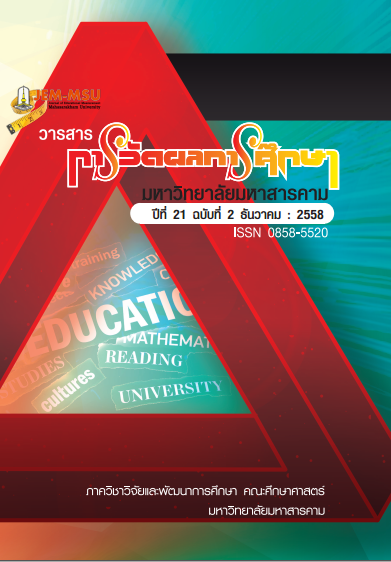Comparisons of English Learning Achievement, Learning Commitment and Learning Attitude of Prathomsuesa 6 Students with Different Rearing Styles and Learning Styles under the Office of Kalasin Primary Educational Service Area Zone 3
Main Article Content
Abstract
There are several factors that should be considered in order to reach the
highest efficiency of teaching and learning including students, teachers, and guardians.
It is generally accepted that there are many differences between learning capability of
each students as well as rearing and learning styles. It can be seen that these
differences may affect learning commitment, learning Attitude, and learning achievement.
This study is mixed method research with quantitative research and qualitative
research ; aimed to examine English learning achievement, learning commitment and
learning Attitude of Prathomsueksa 6 students and compare English learning
achievement, learning commitment and learning Attitude of Prathomsueksa 6 students
with different rearing styles and learning styles. The sample consists of 393
Prathomsueksa 6 students attending schools under the Office of Kalasin Educational
Service Area Zone 3 in the first semester of the academic year 2012, obtained using
the multi-stage random sampling technique. Two types of the instruments used for
collecting data are ; Test 1, part 1 : a 15-item inventory on learning styles with
discriminating powers ranging .302 -.604 and a reliability of .828, part 2 : a 15-item
inventory on learning attitude with discriminating powers ranging .279-.490 and a
reliability of .754, part 3 : a 21-item inventory on rearing styles with discriminating
powers ranging .310-.686 and a reliability of .893, and Test 2 is a 28-item English
achievement test with difficulties ranging .25 - .57, discriminating powers ranging .28-.64
and a reliability of .72. The instruments used for qualitative data is conversation
form with 15-item.
The statistics used for analyzing the collected data are mean, standard
deviation, Pearson Product-Moment correlation coefficient and F-test (Two-way
MANOVA).
The results of the study were as follows:
1. The students had learning commitment at a high level, learning
Attitude at the middle level, English learning achievement at the middle level.
2. The students receiving different rearing styles had different learning
commitment, learning Attitude, English learning achievement ; in which the students
receiving the democratic rearing style showed higher learning commitment than those
receiving the neglected rearing style and the autocratic rearing style at the .05 level of
significance.
3. The students with different learning styles showed different learning
commitment ; in which the students with collaborative learning style had higher
learning commitment than those with independent learning style at the .05 level of
significance.
4. There is no difference on learning attitude and achievement between
different learning styles students at the .05 level of significance.
5. By interviewing : The students with different learning styles showed
different learning commitment ; in which the students with collaborative learning style
had higher learning commitment than those with independent learning style, The
students with different learning styles showed no different learning Attitude and
English learning achievement. The students receiving different rearing styles had
different learning commitment, learning Attitude, English learning achievement ; in
which the students receiving the democratic rearing style showed higher learning
commitment than those receiving the neglected rearing style and the autocratic
rearing style.
In conclusion, the students with different rearing styles and Learning style
had different English learning achievement, learning commitment and learning
Attitude. Therefore, English teachers and parents should be aware of the learning
style and rearing styles which could affect development of the learning commitment,
learning Attitude, English learning achievement and which could result in students
successful in learning English.
Article Details
The content and information contained in the published article in the Journal of Educational Measurement Mahasarakham University represent the opinions and responsibilities of the authors directly. The editorial board of the journal is not necessarily in agreement with or responsible for any of the content.
The articles, data, content, images, etc. that have been published in the Journal of Educational Measurement Mahasarakham University are copyrighted by the journal. If any individual or organization wishes to reproduce or perform any actions involving the entirety or any part of the content, they must obtain written permission from the Journal of Educational Measurement Mahasarakham University.


